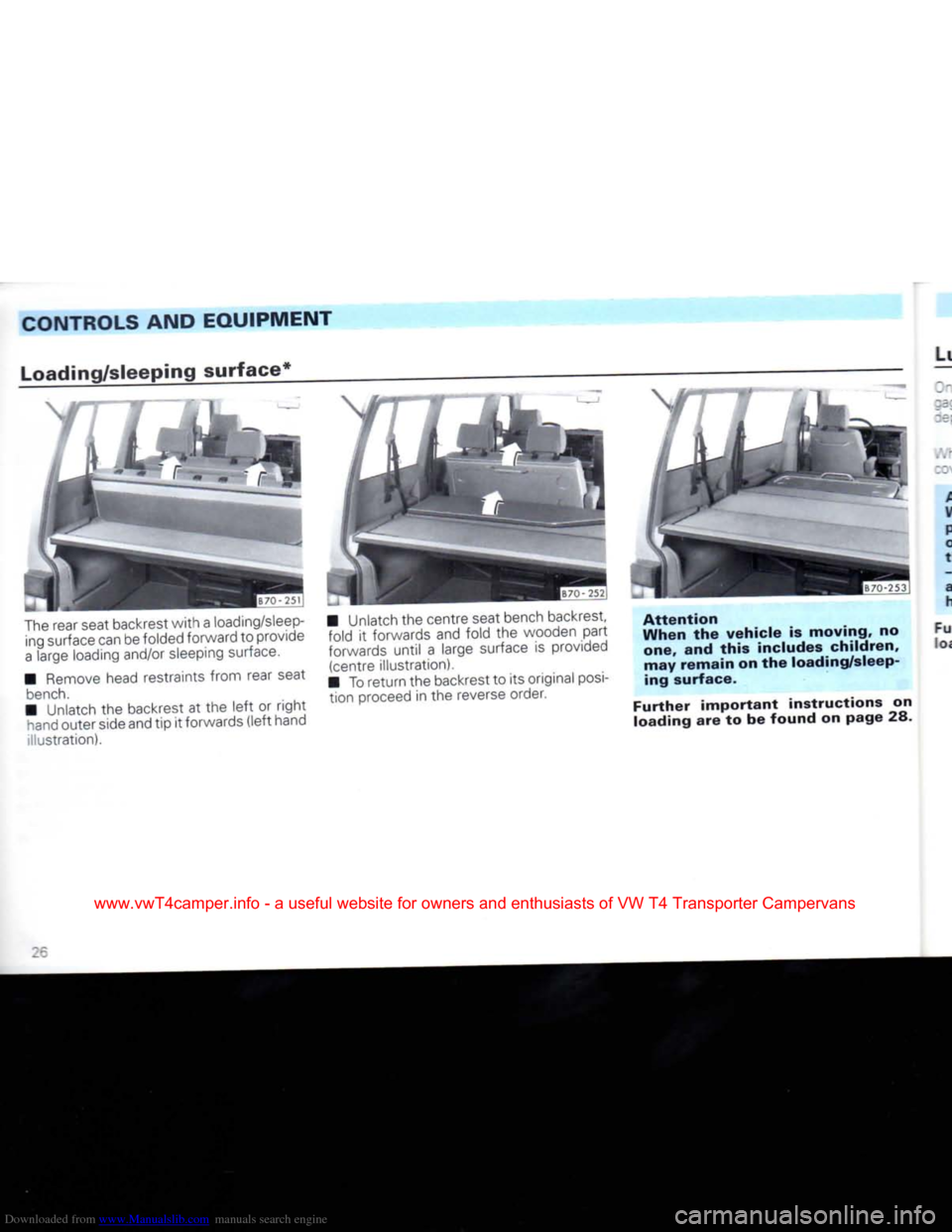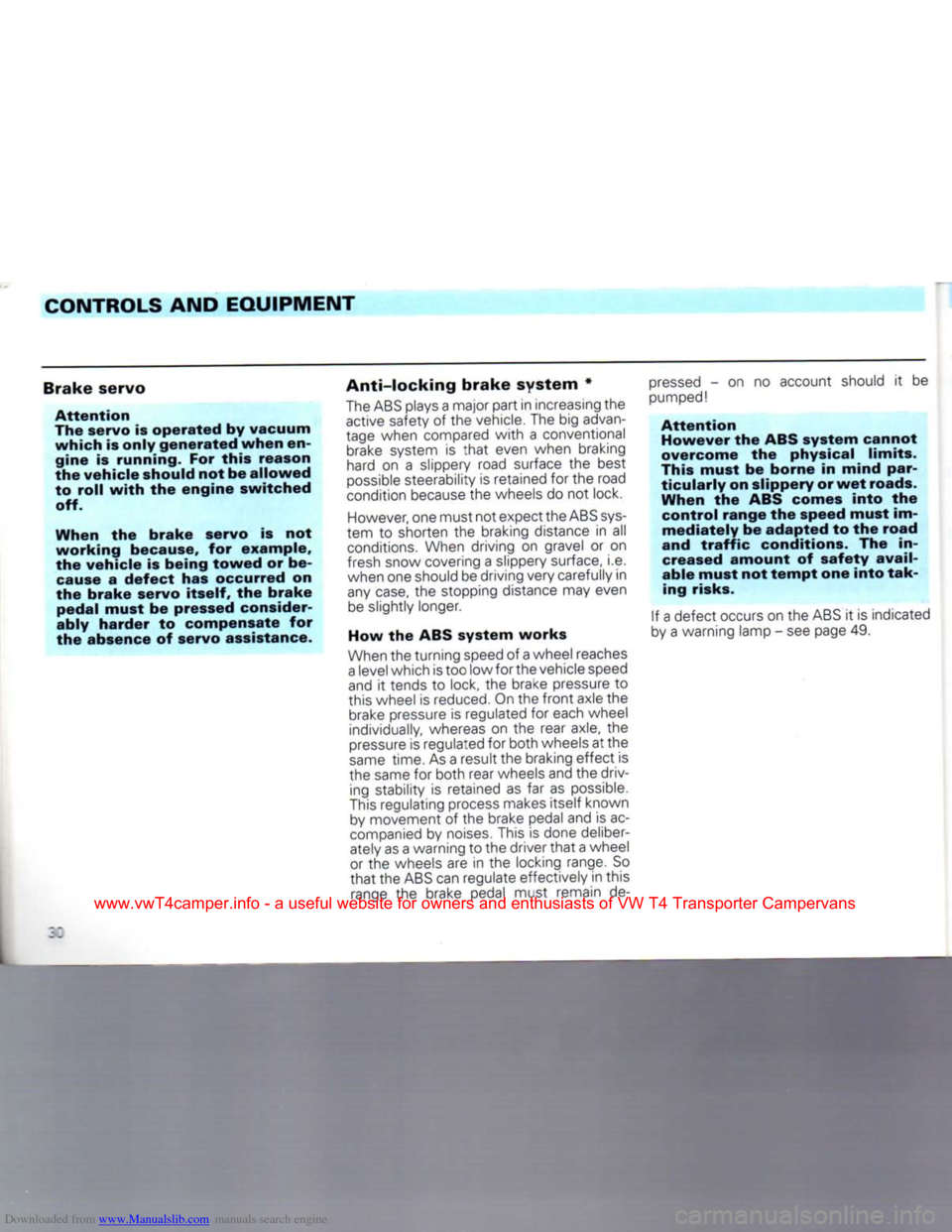1992 VOLKSWAGEN TRANSPORTER Page 97
[x] Cancel search: Page 97Page 26 of 164

Downloaded from www.Manualslib.com manuals search engine
CONTROLS AND
EQUIPMENT
Removing
rear
seat
To
increase the luggage/loading area, the rear seat can be removed:
• Fold backrest of centre seat forwards
• If fitted, fold folding seat* out of way -
see
page 25
• Remove lower seat frame trim* from rear seat
• Remove head restraints* - see page 19
• Fold backrest down - see page 23
• Tip seat forwards - see page 23
• Loosen and remove two bolts (arrows in the
left
illustration)
• Carefully fold seat back • Fold back carpet* to attain
access
to the
front
bolts
• Loosen and remove
front
bolts (arrows in the
right
illustration)
• Remove seat to rear
• Screw in and tighten all four bolts in the securing points.
Fitting
rear
seat
• Fold down backrest of centre bench seat
• If fitted, fold folding seat out of way.
• Fold back carpet and retain
with
some thing heavy
• Remove the four bolts • Fit seat
into
position
• Tighten
front
bolts by hand
(right
illustra
tion)
• Carefully fold seat back
•
Insert
rear bolts
(left
illustration) and tighten all four bolts
Attention
Ensure
that that
the
rear
seat
bench securing
bolts
are
tigh
tened
again,
as the
security
of
the
seat
belts
and
therefore
the
safety
of the passengers
depends
upon
it.
• Fold backrest up
Notes
• It is expedient for two people to carry out the removal and
fitting
of the rear bench
seat.
• When removing and
fitting
the seat en sure
that
the belts, side trim, loudspeaker
grilles etc. are not damaged or soiled.
24
www.vwT4camper.info - a useful website for owners and enthusiasts of VW T4 Transporter Campervans
Page 28 of 164

Downloaded from www.Manualslib.com manuals search engine
CONTROLS AND
EQUIPMENT
Loading/sleeping surface*
The rear seat backrest
with
a loading/sleep ing surface can be folded forward to provide
a
large loading and/or sleeping surface.
• Remove head restraints from rear seat
bench.
• Unlatch the backrest at the
left
or
right
hand outer side and tip it forwards
(left
hand illustration). • Unlatch the centre seat bench backrest,
fold it forwards and fold the wooden part
forwards
until
a large surface is provided (centre illustration).
• To
return
the backrest to its original
posi
tion
proceed in the reverse order.
Attention
When
the
vehicle
is
moving,
no
one,
and
this includes children, may remain
on the
loading/sleeping surface.
Further important instructions
on
loading
are to be
found
on
page
28.
www.vwT4camper.info - a useful website for owners and enthusiasts of VW T4 Transporter Campervans
Page 29 of 164

Downloaded from www.Manualslib.com manuals search engine
CONTROLS
AND EQUIPMENT
igggage
compartment cover*
I
-
/ehicles with
a
rear seat bench,
a
lug-
zazs
compartment cover
can
be
installed, :e rending
on the
vehicle version.
~en loading,
the
luggage compartment
::.
er
can
be
tipped upwards.
Attention
When
the
vehicle
is
moving
no
persons,
animals
or
heavy items
of luggage
are to be
carried
on
the luggage compartment cover
- danger
of
injury when brakes are applied suddenly
or
when vehicle
is
involved
in
an
accident.
further important instructions
on
oading are
to
be
found
on
page 28.
27
www.vwT4camper.info - a useful website for owners and enthusiasts of VW T4 Transporter Campervans
Page 30 of 164

Downloaded from www.Manualslib.com manuals search engine
CONTROLS AND
EQUIPMENT
Luggage
compartment/load
surface
To
enlarge
luggage
space
Lower
backrest and seat as described on
page 23.
Notes
on loading
In the interests of good handling ensure
that
the load (persons and luggage) is distributed evenly. Heavy items should always be carried as near to the rear axle as possible or
better still, between the
axles.
The permissible axle and gross
weights must not be exceeded under any circumstances.
Attention
• It should be noted
that
when
transporting heavy items the handling
will
change due to the
displacement of the centre of
gravity. Driving style and speed must be altered to suit.
• The load must be stowed so
that
no items of luggage can fly
forward if brakes are applied suddenly. - If necessary use the lashing
eyes.
• One should ensure
that
the heater el
ements in the rear window on the Variant
are not damaged by articles rubbing against
them.
• The stale air
escapes
through ventilation openings at the rear. The function of these openings must not be impaired.
Attention
• When vehicle is on the move no persons may be in the luggage
compartment. This includes
children.
Every passenger must
be belted in properly - see page
15.
• Never drive
with
the tailgate or
wing doors not properly closed otherwise exhaust gas can be
drawn
into
the vehicle
interior.
On
vehicles
with
lashing eyes the load
should always be secured to the
eyes.
Each
eye has a tensile strength of 500 kg.
28
www.vwT4camper.info - a useful website for owners and enthusiasts of VW T4 Transporter Campervans
Page 31 of 164

Downloaded from www.Manualslib.com manuals search engine
CONTROLS AND EQUIPMENT
3edals
• e ~ cvement of the pedals must not be re-
:: :~is reason, do not put articles in the
—•".•.ell which could roll or slide underneath
—-E-
zedals.
•Vr^-d the pedal area there should not be •r. -;otmatsorotheradditionalfloorcover- •: -aterials:
• In the
case
of defects on the brake sys-
r~
3 greater pedal travel may be
necess-
• : should always be possible to depress
~3
: _tch and accelerator pedals fully.
• - pedals must be able to return, unhin-
z-z'^z.
to their rest positions,
""•e'efore, the only
foot
mats which may be
are those which leave the pedal area
::—oletely free and which are prevented . " slipping. Brakes
The following points are of particular import
ance
to the safe operation of the brakes.
• New brake linings must also be run in and do not have the optimum
friction
prop
erties during the
first
200 km. The slightly reduced braking effect can be compen
sated for by more pressure on the brake
pedal.
This also applies when new linings have been fitted.
• If the brake pedal travel increases suddenly, it may be
that
one of the two
brake circuits has failed. You can still drive
on to the next Volkswagen dealer but be prepared to use more pressure on the pedal
and allow for longer braking distances on
the way.
• The brake
fluid
level must be checked regularly-see page 105.
The brake warning lamp
will
come on to indi cate
that
the brake
fluid
level is too low (see
also
page 48).
• Brake lining wear depends to a large ex
tent
on the operating conditions and style of driving. On vehicles which are used mainly in
town
traffic
and stop/start conditions or
are driven hard it may be necessary to have
the thickness of the brake linings checked by a Volkswagen dealer in between the in
tervals given in the Service Schedule.
• Change down in good time when driving downhill, in orderto make use of the engine braking effect. This relieves strain on the
brake system. When the brakes are applied do not keep them on con::rjc_s , =" .
and release alternately.
• Under certain operating conditions, *c example after driving through water, a^e' heavy rain or after washing the vehicle the
braking effect may be retarded by wet, or in
winter iced-up brake discs and linings - the brakes must be dried out
first
by applying
the footbrake.
The
full
braking effect may also be delayed when vehicle has been driven for some time
on heavily salted roads
without
using the
brakes,
because the layer of salt on discs
and pads has to be removed
first.
Attention
If a
front
spoiler,
full
size
wheel
trims
etc., is
retrofitted,
it is necessary to
ensure
that
the
flow
of air to the
front
brakes
is not re
stricted
-
otherwise
the
brakes
can
overheat.
www.vwT4camper.info - a useful website for owners and enthusiasts of VW T4 Transporter Campervans
Page 32 of 164

Downloaded from www.Manualslib.com manuals search engine
CONTROLS AND EQUIPMENT
Brake servo Attention
The servo
is
operated
by
vacuum which
is
only generated when
en
gine
is
running.
For
this reason
the vehicle should
not be
allowed
to roll with
the
engine switched off.
When
the
brake servo
is not
working because,
for
example,
the vehicle
is
being towed
or be
cause
a
defect
has
occurred
on
the brake servo itself,
the
brake pedal must
be
pressed consider
ably harder
to
compensate
for
the absence
of
servo assistance. Anti-locking brake system
*
The ABS plays a major part in increasing the
active safety of the vehicle. The big advan
tage when compared with a conventional brake system is that even when braking
hard on a slippery road surface the best
possible steerability is retained for the road
condition because the wheels do not lock.
However, one must not expect the ABS sys
tem to shorten the braking distance in all conditions. When driving on gravel or on
fresh snow covering a slippery surface, i.e.
when one should be driving very carefully in
any case, the stopping distance may even be slightly longer.
How
the ABS
system works
When the turning speed of a wheel reaches
a level which is too lowforthe vehicle speed
and it tends to lock, the brake pressure to
this wheel is reduced. On the front axle the brake pressure is regulated for each wheel
individually, whereas on the rear axle, the
pressure is regulated for both wheels at the
same time. As a result the braking effect is
the same for both rear wheels and the driv ing stability is retained as far as possible.
This regulating process makes itself known by movement of the brake pedal and is ac
companied by noises. This is done deliber
ately as a warning to the driver that a wheel
or the wheels are in the locking range. So
that the ABS can regulate effectively in this range the brake pedal must remain de pressed - on no account should it be
pumped!
Attention However
the ABS
system cannot
overcome
the
physical limits.
This must
be
borne
in
mind par
ticularly
on
slippery
or wet
roads.
When
the ABS
comes into
the
control range
the
speed must
im
mediately
be
adapted
to the
road
and traffic conditions.
The in
creased amount
of
safety avail
able must
not
tempt
one
into tak ing risks.
If a defect occurs on the ABS it is indicated
by a warning lamp - see page 49.
www.vwT4camper.info - a useful website for owners and enthusiasts of VW T4 Transporter Campervans
Page 37 of 164

Downloaded from www.Manualslib.com manuals search engine
CONTROLS
AND EQUIPMENT
Notes on driving Starting
\
e
engine
can only be started when
selec-
pr
ever
is at
"N"
or
"P".
See
also
"Starting
Br:
re" on
page
37.
Selecting
a driving range When the vehicle is stationary and
the engine is running always de
press
the foot brake when selecting
i gear.
When the vehicle is stationary do
•ot depress the accelerator when
•electing a gear. f the lever is moved accidentally nto "IM" when driving, release ac
celerator and let the engine speed
trop to idling before selecting a for
ward
gear again.
•
Attention
•
When the engine is running it
is
necessary to hold the vehicle
with
the foot brake in all gears.
Because
with
an automatic gear
box the transfer of power is not
fully interrupted even at idling
speed
- and the vehicle tends to
"creep".
When the vehicle is stationary
and a gear is engaged, the
throttle
must not be opened inad
vertently
on any account (for in
stance
by hand from the engine
compartment). Otherwise the vehicle
will
move immediately -
even if the handbrake has been
fully applied.
Before working on the vehicle
with
the engine running, apply
the handbrake and put the selec
tor lever in "P".
Moving off
Select
driving
range
(R, D, 3, 2, 1).
Wait
until
the gearbox has
shifted
and the
power
flow
is made to the
driving
wheels
(light
selection
jerk
perceptible).
Then
one can accelerate.
Stopping
To
stop
vehicle
temporarily
such
as at traffic
lights,
it is only
necessary
to
apply
the
brakes.
It is not
necessary
to
move
selector
lever
to
"N".
The
engine
should
however
only
be running at idling
speed.
Parking
On
level
ground all you
need
do is
engage
the
parking
lock.
On a gradient the
hand
brake
should
be
applied
firmly first
and
then
the
parking
lock
engaged.
This
will
ensure
that the
locking
mechanism
is not too
heav
ily
loaded
and
makes
the
lock
easier
to
dis
engage.
Tow starting
On
vehicles
with
automatic
gearbox
the en
gine
cannot
be started by towing or
pushing
the
vehicle.
See
page
133.
When
the battery is flat, the
engine
can be
started
from the battery of another
vehicle
by
using
jumper
cables.
See
"Emergency
starting",
page
130.
Towing If the
vehicle
has to be towed at any time,
you
must
read
the instructions in the
sec
tion
"Towing/tow
starting on
page
132.
www.vwT4camper.info - a useful website for owners and enthusiasts of VW T4 Transporter Campervans
Page 39 of 164

Downloaded from www.Manualslib.com manuals search engine
CONTROLS AND EQUIPMENT
Starting
the
engine
General
hints
Attention
When
starting
the
engine
in con
fined
spaces
there
is a
danger
of poisoning.
• Before starting, move gear lever to neu- ml
(with
automatic gearbox, selector lever -
"P"
or "N" position) and apply handbrake
I 'mly.
• On vehicles
with
a manual gearbox de-
:"9ss
the clutch pedal when operating
=:arter
so
that
starter only has to
turn
en
gine.
• As soon as engine starts, release the gnition key so
that
starter can disengage.
• After starting a cold engine it may sound
_oisy
for a moment or two because the oil pressure has to build up in the hydraulic
tappets
first.
This is normal and no cause for
a
arm. Do not
warm
engine
up by run-
W>
ning
it
with
vehicle
stationary.
Drive
off
straight
away.
Do
not overrev or use
full
throttle
until the
engine has reached the normal operating
Temperature. • On vehicles
with
a
catalytic
con
verter
the
engine
must
not be
started
by
towing
the
vehicle
in ex
cess
of 50 m.
Otherwise
unburnt
fuel
can pass
into
the
converter
and
lead
to
damage.
•
Before
trying
to
start
engine
by
towing,
the
battery
from
another
ve
hicle
should be used for
starting
if
possible - see
page
130.
Petrol
engines
These
engines are equipped
with
a cer: ~-
jection system
that
automatically s^c; es the correct fuel/air mixture at ail anc e~:
temperatures.
When
engine is cold or at
operating
temperature
do not accelerate before or
during the starting procedure.
Applicable to all engines:
If the engine does not start at once, stop
using
the starter after 10
sees,
wait about
half a minute and then try again. If the engine still does not start, the electric
fuel pump fuse may have blown - see page
122.
When
the engine is
very
hot it may be
necessary
to accelerate slightly after the
engine has started.
37
www.vwT4camper.info - a useful website for owners and enthusiasts of VW T4 Transporter Campervans